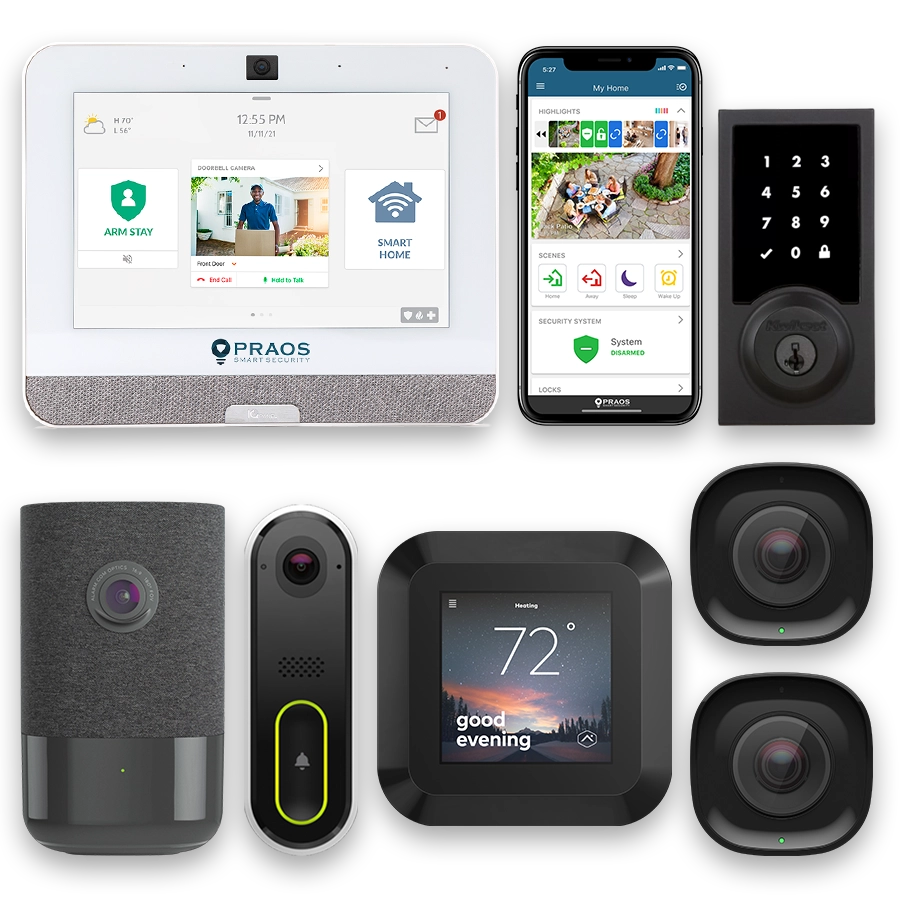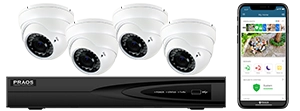- Introduction to Home Security: Historical Context and Technological Evolution
- Components and Features of Traditional Security Systems
- Components and Features of Smart Home Security Systems
- Performance and Reliability: Comparing Traditional and Smart Systems
- User Experience and Accessibility: Traditional vs. Smart Systems
- Cost-Benefit Analysis: Initial Investment and Long-term Expenses
- Future Trends and Innovations in Home Security
Introduction to Home Security: Historical Context and Technological Evolution
Home security systems have played a vital role in protecting residential properties for decades. Traditionally, these systems relied on tangible elements like locks, alarms, and surveillance cameras. Over the last few decades, however, technological advancements have paved the way for more sophisticated solutions, blending wireless technology, artificial intelligence, and the Internet of Things (IoT).
The concept of home security dates back to ancient times when physical barriers and security measures were primarily used. Early methods included barriers like walls, locks, and rudimentary alarms, often leveraging mechanical systems. However, the 20th century saw significant innovations in home security systems, leading to the development of electronic systems, which included wired burglar alarms and surveillance cameras.
By the 1960s, security companies began to introduce more advanced alarm systems that were connected to a central monitoring station. This allowed for quicker responses to security breaches and brought about a marked improvement in the effectiveness of home security systems. The industry saw a further leap during the 1980s and 1990s with the advent of digital technology, enhancing both the accuracy and reliability of security systems.
The early 2000s marked the beginning of the modern era of smart home security. The integration of web connectivity and wireless communication brought forth the concept of smart homes. This evolution was fueled by rapid technological advancements, widespread internet access, and the proliferation of smart devices. IoT’s role became prominent, enabling homeowners to monitor and control their security systems remotely via smartphones and other connected devices.
The transition from traditional to smart home security systems can be seen as part of the broader digital transformation occurring across various sectors. Below is a table summarizing some key milestones in the history of home security:
| Time Period | Key Developments |
|---|---|
| Ancient Times | Use of physical barriers such as walls, gates, and locks |
| Late 19th Century | Invention of the first electromagnetic alarm system |
| 1960s | Introduction of central monitoring stations for alarm systems |
| 1980s-1990s | Advent of digital security systems, including wired surveillance cameras |
| Early 2000s | Emergence of smart home security systems utilizing wireless technology and IoT |
Today, the landscape of home security is more diverse than ever. Traditional security systems are still in use and have evolved to include more advanced features. Concurrently, smart home security systems continue to gain popularity, offering increased connectivity, real-time notifications, and seamless integration with other smart devices in the home.
Components and Features of Traditional Security Systems
Traditional security systems have been the cornerstone of home protection for decades. These systems typically comprise several fundamental components designed to deter intruders, detect unauthorized entry, and alert homeowners and authorities.
Main Components of Traditional Security Systems
The primary elements of traditional security systems can be categorized as follows:
- Control Panel: The control panel serves as the heart of the system, integrating various devices and sensors. It allows for programming and system management, typically through a keypad interface.
- Door and Window Sensors: These sensors are installed on doors and windows to detect when they are opened. They consist of two parts: one installed on the door or window frame and the other on the actual door or window.
- Motion Detectors: Motion detectors sense movement within specific areas of a home. They are usually installed in rooms, hallways, or entryways to detect unauthorized activity.
- Alarm Sirens: When a potential breach is detected, alarm sirens emit a loud sound to alert residents and deter intruders. These sirens are typically mounted in central locations inside the home.
- Wired or Wireless Connectivity: Traditional security systems can be either hardwired or wireless. Hardwired systems require physical cabling between components, whereas wireless systems communicate via radio signals.
- Backup Power Supply: To ensure continued operation during power outages, traditional systems often include a backup battery.
Monitoring and Response Services
A significant feature of traditional security systems is professional monitoring. Once an alarm is triggered, a signal is sent to a monitoring center, which can then verify the alarm and dispatch emergency services if necessary.
- Professional Monitoring: Typically involves a monthly subscription fee. The monitoring center operates 24/7 to manage alerts and coordinate with law enforcement, fire departments, or medical responders.
- Local Alarms: In some configurations, alarms are designed to alert only the homeowners without professional intervention. These systems rely on the residents’ prompt action to contact authorities.
Installation and Maintenance
Traditional security systems often require professional installation, especially for hardwired setups, to ensure proper and secure installation of all components. Regular maintenance, such as battery replacements and system testing, is essential to maintain functionality.
- Professional Installation: Ensures that all components are correctly set up and integrated. Technicians are typically responsible for configuring the system and providing user training.
- System Testing: Regular system tests are recommended to verify that all sensors, alarms, and connections are working as intended. This helps to prevent false alarms and ensures readiness in an emergency.
In summary, traditional security systems offer a solid and proven approach to home security. They encompass a range of components that work together to provide reliable protection, with the option for professional monitoring enhancing the system’s effectiveness.
Components and Features of Smart Home Security Systems
Smart home security systems leverage advanced technology to offer enhanced protection and convenience. One of the primary components of these systems is the smart security camera. These cameras provide high-definition video quality and often come with features such as motion detection, night vision, and two-way audio. Many models offer cloud storage, allowing users to access footage remotely via their smartphones or computers.
Another integral component is the smart door lock. These locks can be controlled remotely through a mobile app, enabling users to lock and unlock their doors from anywhere. Additional features may include biometric sensors, such as fingerprint recognition, and integration with other smart home devices.
The smart alarm system is a fundamental feature, designed to detect unauthorized entry. These systems typically include door and window sensors, motion detectors, and alarm sirens. Many smart alarm systems can be integrated with other smart devices and are monitored remotely by security services or by the user themselves through a dedicated app.
Environmental sensors such as smoke, carbon monoxide, and water leak detectors are also commonly included in smart home security setups. These sensors notify users of potential hazards, allowing for immediate action to prevent damage or injury.
Smart home security systems often feature home automation integration. This means they can be synchronized with other smart devices in the home, such as lights, thermostats, and garage door openers, to create a seamless and convenient security ecosystem. For instance, lights can be programmed to turn on automatically when motion is detected, or the thermostat can be adjusted based on occupancy detected by security sensors.
One of the significant advantages of smart home security systems is their remote access and control. Users can monitor and manage their security system through smartphone apps, which typically offer real-time alerts, live video feeds, and the ability to perform actions such as locking doors or sounding alarms from any location with internet access.
Smart home security systems also benefit from regular software updates. These updates can enhance system functionality and security without the need for physical hardware changes. Additionally, some systems employ artificial intelligence to improve functionality, such as distinguishing between ordinary movements and potential threats, reducing false alarms.
An essential aspect of smart home security is the focus on user customization and scalability. These systems often offer a range of customizable settings and can be easily expanded with additional components as needed, providing flexibility to meet the specific needs of any household.
Lastly, smart home security systems generally offer a variety of communication protocols, such as Wi-Fi, Zigbee, and Z-Wave, which enable seamless integration with other smart devices and platforms, allowing for a unified and interoperable home security solution.
Performance and Reliability: Comparing Traditional and Smart Systems
When evaluating the performance and reliability of traditional and smart home security systems, several key factors must be considered. This chapter aims to provide a comprehensive comparison based on empirical data and industry standards.
Response Time
Response time is crucial in home security as it determines how quickly a system can detect and respond to an intrusion or emergency. Traditional security systems typically rely on wired connections and direct links to monitoring centers, which can result in a somewhat faster and more stable response under optimal conditions. Conversely, smart home security systems depend on internet connectivity, which can vary in speed and reliability based on the user’s internet service provider (ISP) and Wi-Fi quality.
System Downtime and Maintenance
System downtime and maintenance are important aspects of reliability. Traditional systems, being hardwired, generally experience fewer interruptions caused by power outages or connectivity issues. However, they do require regular checks and maintenance performed by professionals. Smart systems may face occasional downtimes if there are network issues or updates are needed. However, many smart systems are equipped with redundancy features such as battery backups and alternative communication methods (e.g., cellular networks) to enhance reliability.
False Alarms
False alarms can undermine the credibility and efficacy of any security system. Traditional systems, with their straightforward sensor technology, may experience fewer false alarms when installed correctly. However, smart home security systems can utilize advanced algorithms and machine learning to minimize false alarms by better distinguishing between real threats and benign activities.
Scalability and Adaptability
The ability to scale and adapt is vital for accommodating changes in security needs. Traditional systems may require significant adjustments or professional upgrades to expand. In contrast, smart home security systems offer greater flexibility, enabling users to easily add or remove devices through mobile applications and integration with other smart home devices.
Incident Recording and Evidence Gathering
In terms of recording incidents and gathering evidence, smart systems offer a notable advantage. They often come with integrated cameras and cloud-based storage that allow users to review footage from anywhere. Traditional systems might rely on local storage solutions, which can be limited and accessible only on-site. However, such systems are often seen as more secure from hacking since they don’t rely on the internet.
Real-time Alerts and Monitoring
Smart home security systems excel in providing real-time alerts and monitoring through smartphones and other connected devices, allowing for immediate user intervention. Traditional systems mainly notify monitoring centers, which then contact homeowners or emergency services, introducing a potential delay. However, professional monitoring can be more consistent and less prone to inaccuracies.
Overall, both traditional and smart home security systems have distinct strengths and, weaknesses in terms of performance and reliability. The best choice depends on individual preferences and specific requirements, such as the importance of immediate alerts versus the desire for professional monitoring.
User Experience and Accessibility: Traditional vs. Smart Systems
In evaluating the user experience and accessibility of traditional security systems versus smart home security systems, several key factors come into play. These include ease of installation, daily usability, and the availability of remote management options.
Ease of Installation
Traditional security systems often require professional installation. This process can be time-consuming and involves wiring and physical connections throughout the home. Professional installation ensures that all components are correctly installed and configured, providing peace of mind that the system is operational from the get-go.
In contrast, smart home security systems tend to be more user-friendly in terms of installation. Many modern smart security systems offer DIY installation that does not require extensive technical knowledge. Wireless components and adhesive mounting options make the setup process simpler and more flexible, allowing users to configure their systems according to personal preferences.
Daily Usability
Traditional security systems usually operate through a central control panel. Users must engage with this panel to arm or disarm the system, often through a keypad with a passcode. While effective, this method can be less convenient, especially for individuals who may have difficulty remembering passcodes or navigating less intuitive interfaces.
Smart home security systems, on the other hand, offer a more streamlined and intuitive user experience. These systems often come with mobile apps that allow users to control features via smartphones or tablets. In addition, smart systems can integrate with other home automation devices, enabling voice control through virtual assistants like Amazon Alexa or Google Assistant.
Remote Management Options
Traditional security systems typically do not offer the same level of remote access as their smart counterparts. While some traditional systems now offer limited remote management options, these are often additional features that require extra costs and setup.
Smart home security systems excel in remote management capabilities. Users can receive real-time alerts and notifications, view live video feeds, and control their systems from virtually anywhere via an internet connection. This level of control and accessibility enhances the overall user experience, providing an extra layer of convenience and peace of mind.
Integration with Other Systems
Traditional security systems generally operate as standalone setups. While reliable, they are often not designed to integrate seamlessly with other home automation technologies.
Smart home security systems are built with integration in mind, allowing users to create a cohesive smart home environment. Security features can be synchronized with lighting, climate control, and other smart appliances to create comprehensive automation routines that enhance both security and convenience.
Conclusion
When comparing user experience and accessibility, smart home security systems offer significant advantages over traditional systems. The ease of installation, improved daily usability, advanced remote management options, and seamless integration with other smart devices provide a more flexible and user-friendly experience. However, individual preferences and specific security needs should ultimately guide the choice between these two types of systems.
Cost-Benefit Analysis: Initial Investment and Long-term Expenses
When choosing between traditional and smart home security systems, a critical factor to consider is the cost. A detailed cost-benefit analysis is essential to understand both the initial investment and long-term expenses involved with each type of system.
Traditional security systems typically involve a variety of upfront costs. These may include purchasing hardware such as control panels, sensors, and cameras, as well as professional installation fees. According to Consumer Reports, the average cost for a traditional home security system ranges between $600 to $1,200. Monthly monitoring fees, which are essential for professional response services, add another $20 to $60 per month.
In contrast, the initial setup cost for smart home security systems can be both higher or lower, depending largely on the brand and complexity of the system chosen. Basic kits from companies like Ring or SimpliSafe start at around $200 to $500. However, more advanced systems from companies like Vivint or ADT with smart integrations and extensive features can exceed $1,500. The professional installation of smart systems, albeit optional in many cases, can add another $100 to $500 to the initial investment.
Over the long term, smart home security systems may offer cost-saving benefits stemming from their DIY installation options and potential lower monthly monitoring fees. For instance, many smart security systems offer self-monitoring options, eliminating or reducing the need for monthly fees. A report by Statista notes that the average monthly cost for smart home security monitoring ranges between $10 to $30, which can be lower than traditional systems.
Additionally, smart security systems often feature a higher degree of customization and scalability, allowing homeowners to start with a basic setup and expand as needed. This flexibility can help distribute costs over time rather than committing to a significant upfront investment.
It’s also important to consider the potential for insurance savings. Both traditional and smart security systems can qualify homeowners for insurance discounts. However, a study by the Insurance Information Institute highlights that smart home systems may lead to more substantial premium reductions due to their advanced functionalities, such as real-time alerts and remote monitoring, which are viewed as enhancing overall home safety.
Ultimately, the cost-benefit analysis of traditional versus smart home security systems will depend on individual needs, preferences, and budget constraints. While traditional systems may represent a more substantial initial financial commitment with consistent monthly fees, smart home security systems offer flexibility and potential long-term savings, especially for technologically inclined users willing to self-install and monitor their systems.
Future Trends and Innovations in Home Security
The home security industry is continuously evolving, driven by advancements in technology, societal changes, and consumer preferences. Understanding future trends and innovations in this field can help consumers make informed decisions about their home security choices.
Integration with Internet of Things (IoT)
The integration of home security systems with IoT devices is expected to grow significantly. IoT allows for a seamless connection between security systems and other smart home devices, enabling real-time monitoring, automated responses, and enhanced user control.
- Increased connectivity between devices such as cameras, door locks, lights, and environmental sensors.
- Potential for enhanced data analytics to predict and prevent security breaches.
Artificial Intelligence and Machine Learning
Artificial Intelligence (AI) and Machine Learning (ML) are expected to revolutionize home security by enabling systems to process large amounts of data and identify patterns more effectively.
- Enhanced accuracy in threat detection and false alarm reduction.
- Personalized security settings based on user behavior and preferences.
- Predictive capabilities to forecast potential security threats.
5G Technology
The rollout of 5G networks is poised to enhance the performance of smart security systems. With higher data transfer speeds and lower latency, 5G will improve real-time monitoring and response capabilities.
- Faster and more reliable communication between security devices.
- Improved video streaming quality for surveillance cameras.
Blockchain Technology
Blockchain technology offers potential benefits for home security, particularly in enhancing data security and privacy.
- Secure and tamper-proof logging of security events.
- Decentralized data storage to prevent unauthorized access.
Biometric Authentication
Biometric authentication methods, such as fingerprint, facial recognition, and voice recognition, are becoming increasingly prevalent in home security systems for providing an additional layer of security.
- Greater accuracy and reduced risk of unauthorized access.
- Convenient and user-friendly authentication options.
Environmental Sensing and Automation
Future home security systems are likely to incorporate advanced environmental sensors that can detect various conditions such as smoke, fire, water leaks, and air quality.
- Automated responses to environmental hazards, such as shutting off water valves or alerting emergency services.
- Integration with smart home automation for comprehensive home management.
Conclusion
As technology continues to advance, home security systems will become more sophisticated, offering enhanced protection and convenience. Keeping up with these trends and innovations can help homeowners choose security solutions that best meet their needs, ensuring a safe and secure living environment.






